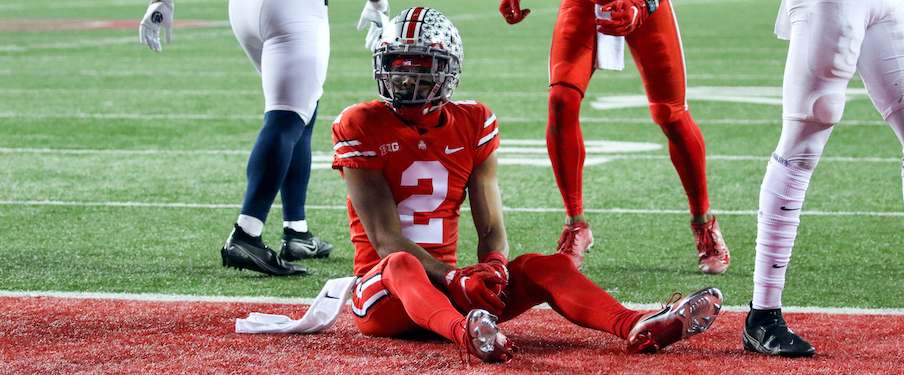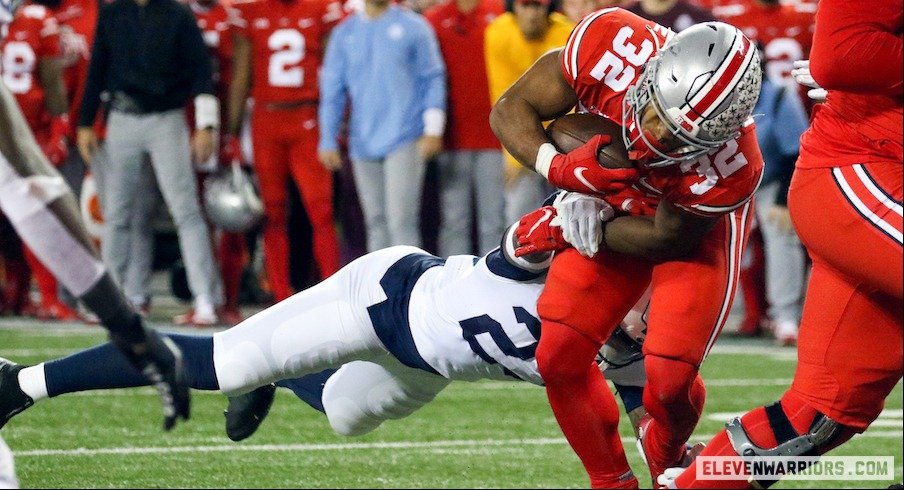After scoring just about every time it had the ball when C.J. Stroud was on the field in its previous three games, the Ohio State offense hit a road block against Penn State.
In six drives inside the red zone against the Nittany Lions, Ohio State scored a touchdown just once. While the Buckeyes put up 466 yards of offense in their 33-24 win, their offense repeatedly stalled inside the 20-yard line, where Ohio State settled for four short field goals and had a turnover on downs.
When Ohio State has a problem it needs to diagnose, Ryan Day says the Buckeyes look at coaching, scheme and personnel to determine where they need to be better. In this case, Day believes the Buckeyes’ execution and play calling both need to be better in the red zone than they were against Penn State.
“I think when we look back, we could have executed much better,” Day said Tuesday. “Certainly in some of the shorter yardage situations, we got ourselves with a penalty a couple times with a false start. Any time you do that down in the red zone, five yards seems like a mile away. So certainly that was part of it. I also think there were some schematic things, probably looking back on it, could have done a better job of.”
As Day mentioned, penalties were one big reason why Ohio State struggled in the red zone against Penn State. Three of the four field goals the Buckeyes settled for came after false starts by Chris Olave, TreVeyon Henderson and Thayer Munford, respectively. For the game as a whole, Ohio State was called for a season-high 10 penalties, including five false starts as well as two snap infractions against Luke Wypler.
Day believes the way Penn State used pre-snap movement on defense contributed to that, so the Buckeyes are spending more time in practice this week working on how to prepare for defensive looks they might not have seen before, though Day said that doesn’t excuse the mistakes.
“I think some of the pre-snap movement a little bit, for Luke especially at center, got us a little bit out of whack there,” Day said. “But there was nothing else in particular that we can point to in that area other than just lack of focus and discipline, and we’ve gotta do a better job of that this week.”
Olave said red zone execution was a big point of emphasis as the Buckeyes broke down the film from the Penn State game and began their preparation for this week’s game against Nebraska on Sunday.
“When I heard we went 1-for-6, I was kind of shocked,” Olave said Wednesday. “But we just gotta communicate, execute, try to just be better in the red zone.”
C.J. Stroud wasn’t sharp in the red zone against Penn State either, completing just two of his seven passing attempts inside the 20-yard line and only one for positive yardage. Most notably, Stroud missed an open Olave in the end zone on a 4th-and-3 pass from the 13-yard line, resulting in the Buckeyes leaving the red zone with zero points.
“It was just my fault, I just underthrew it. But at the end of the day, those type of plays happen,” Stroud said. “There were other plays in the drive that we could have scored and we just didn’t, so it’s all about just keep going.”

Ohio State’s play calling can also be pointed to as a reason why the Buckeyes struggled in the red zone against Penn State. Fifteen out of the 24 plays Ohio State ran inside the 20-yard line against Penn State were run plays (two of the nine passing plays resulted in Penn State penalties), and most of those were straight-ahead runs between the tackles, where the Buckeyes had little success no matter where they were on the field against the Nittany Lions. While Ohio State has been more creative and used more motion in the red zone in the past, the lack thereof against Penn State was partially by design.
“When you do stuff like that, you’re not sure of the look (you’re getting from the defense),” Day said. “When you stay stationary, you can kind of identify what the look is, and then try to get into the best play possible. So that’s what we were doing in that game.”
Since the Buckeyes weren’t effective in the red zone against Penn State, Day and the rest of Ohio State’s offensive coaching staff will go back to the drawing board to improve their game plan in the red zone going forward. Ohio State wide receivers coach Brian Hartline believes the Buckeyes’ struggles to finish drives against Penn State will force them to think about what they need to do better, and he says that’s a good thing since Ohio State ultimately won the game.
“We have to be better as coaches, putting guys in positions to be successful, communicating the expectations on certain plays play in and play out maybe, and the players gotta do a good job of executing it,” Hartline said.
If Day’s comments on Tuesday were any indication, though, running the ball will continue to be a major part of the Buckeyes’ game plan in the red zone, as running the ball in the red zone is something he believes they simply have to be able to do effectively in order to win big games down the stretch.
“I think you have to be able to win down in the red zone running the football. You just do. If you want to go win championships, you have to be able to do that. And we didn’t do that well enough down there,” Day said. “Three- and four-yard gains have to turn into five and six. We’ve done a really good job of throwing down there, we have to do a better job of running the ball. And that’s just the bottom line.”
Going into the Penn State game, Ohio State had been among the more efficient teams in the country at scoring in the red zone, turning 29 red zone trips into 23 touchdowns. Penn State held opponents to just eight touchdowns on 29 red zone drives (27.6%) this season, and that’s the best mark in the entire Football Bowl Subdivision, so Ohio State fans shouldn’t panic about the Buckeyes having one bad game in that area.
When coupled with the fact that Ohio State scored just four touchdowns on 612 yards of offense in its loss to Oregon, however, it’s fair to say the Buckeyes have struggled to finish off drives when they’ve played against top competition, making that an area where Ohio State still has something to prove even though it still leads the nation in points and yards per game.
“I think statistically speaking, we’ve done a pretty good job down there and always have,” Day said. “But there was times in both of those games where we just haven’t finished drives. You can point the finger at a lot of things, but you have got to execute at a high level in the pass game and then you have to be able to be really physical in the run game and make 3-yard runs 5-yard runs. And the minute you get off-schedule or take a negative play, you put yourself at risk because you just run out of room. Against good defenses, you have to be on point there and certainly have a plan to win.”


